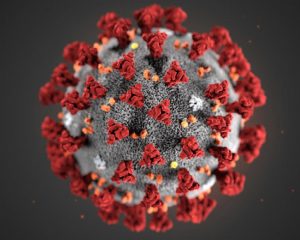Are immigrants more susceptible to COVID-19?
Are immigrants more susceptible to COVID-19?

Ethel Tungohan
Researchers, advocacy groups want more data
By Ysh Cabana
The Phillippine Reporter
Is COVID-19 hitting harder Canada’s immigrants, particularly Filipinos?
That’s what several Filipino-Canadian researchers, together with advocacy groups, want to know, and they are asking for demographic data to back up concerns on historically disenfranchised groups having higher risk of contracting the coronavirus-related respiratory illness.
Ethel Tungohan, Canada Research Chair in Canadian Migration Policy, Impacts and Activism, based at York University, supports calls of the need to bring race into discussions of the political economy of care amid COVID-19, with a view to adjusting public health policies.

Illustration:
A digital illustration of the coronavirus shows the crown-like appearance of the virus courtesy of Centers for Disease Control and Prevention
“It is crucial for policymakers to get race-based data to understand the risks that different communities face when it comes to COVID-19; as well as the ways in which migrant workers like those in the Fillipino community are impacted,” Tungohan writes for Broadbent Institute, a policy think tank.
“Only through the acquisition of race-based data can policy solutions that are attentive to the needs of specific communities be passed,” she adds.
A handful of provinces and major cities are set to begin asking questions surrounding race, ethnicity and Indigenous identity. Manitoba’s public health office is directing all healthcare providers to collect identifiers to those who test positive for COVID-19 starting May 1.
Peel Public Health, which serves residents in Mississauga, Brampton, and Caledon, is also piloting a collection project to gather race- and occupation-based data, as is being done in Toronto. However, York region is not following suit until further direction from the province of Ontario.
As some advocates are calling for standardization across the board, Ontario must commit to collaboration with labour to ensure the inclusion of equity-seeking groups, according to the Ontario Federation of Labour (OFL).
“Social determinants of health make equity-seeking groups more vulnerable to COVID-19. Income, race, and employment conditions have effects on immune-system functioning. At the same time, these groups often face greater exposure to the virus because of crowded housing and the urgent need for financially insecure people to work, whether or not their workplaces take precautions to prevent the spread of the virus,” said OFL in a statement.
Ontario government’s earlier position is that “statistics based on race aren’t collected in Canada unless certain groups are found to have risk factors,” as per Dr. David Williams, the province’s chief medical officer of health.
Ironically, if data are not collected, one cannot examine high incidents of COVID-19 in multiracial areas, says the Centre for Research-Action on Race Relations. Thus, the race relations group is campaigning for authorities in Quebec to take note.
The lack of disaggregated data is seen at the federal level, too. Canada’s chief public health officer Dr. Theresa Tam said the government is collecting ‘detailed confirmed cases of coronavirus disease’ data, which is hosted by Statistics Canada online. But the epidemiological report only included information about patients’ age and gender and no other demographic features.
The paucity of the data shared by the provinces with Public Health Agency of Canada was repeatedly been criticized by infectious disease and mathematical experts who point out it isn’t separated geographically and data gap includes the dates of first symptoms from lab testing dates to the date a case was reported to health authorities.
J.P. Catungal, a professor at UBC’s Social Justice Institute, said Canada underestimates how “racially and ethnically differentiated” are essential services. Filipino-Canadians are over-represented in essential industries such as healthcare, long-term care, and food service, he added.
“We need to know whether and how these pre-existing vulnerabilities are affecting instances and recovery and hospitalization of people who are exposed to COVID-19,” said Catungal.
There might not be data, but there is evidence that Filipinos, or more precisely women from the Philippines, are overrepresented in the frontlines and might be at higher risk for contracting COVID-19.
Racialized population make up 22 per cent of Canada’s population, compared to 16 per cent a decade earlier. Excluding Indigenous peoples, the largest racialized groups are made up of those who identify as South Asian (25.1 per cent), Chinese (20.5 per cent) and Black (15.6 per cent) followed by Filipinos (10.2 per cent), according to 2016 census.
The over-representation of women also comes clear in health care-social assistance and technical services. For example, currently in Canada only one in every twenty nurses are male according to Labour force survey by Statistics Canada.
Indeed, with the continued increase of internationally educated nurses (IENs) incorporated into the workforce, the Philippines leads in numbers making up approximately one fifth of the Canadian supply. In 2016, 34.4 per cent of IENs registered across all nursing designations are from the Philippines.
A recent article on American health-oriented newsite Stat featured that the coronavirus is disproportionately affecting Filipino nursing ranks in the U.S.
Tungohan has noted that Filipino migrant healthcare workers who are at high risk for contracting the virus including personal support workers, licensed practical nurses, and in-home caregivers need more attention.
“Without the care work provided by Filipino migrant care workers, many countries would have a difficult time coping with high health care demands, particularly during a pandemic.”
“One cannot emphasize enough why obtaining race-based data is so crucial for sound policymaking.”
Comments (0)